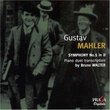Wonderous.
Tom Brody | Berkeley, CA | 10/01/2004
(5 out of 5 stars)
"The disc consists four movements: Langsam. Schleppend. Wie ein Naturlaut (14 minutes and 38 seconds); Kraftig bewegt (7:39); Feierlich und gemessen, ohne zu schleppen (12.06); and Sturmisch bewegt (21:12). (It seems that a good deal of schlepping is going on here. I know what schlepping is. But what is a bewegt?)
The sound quality is excellent. The microphone appears to be up close to the piano, and the higher frequencies are right out in the open, though the treble is not as high as found in most of Maurizio Pollini's recordings for Deutsche Grammophone. The tone quality of the recording being reviewed is sharper than that found in the Harmonia Mundi piano recordings of the Beethoven symphonies, e.g., Michel Dalberto's rendition of the 6th, and Paul Badura-Skoda's rendition of the 5th. The Harmonia Mundi recordings appear to have been made with a microphone located at the other end of the room, and the tone quality could almost be described as "mushy."
Chitose Okashiro's recording is excellent for those who love Mahler, but who want to relax a little and are not in the mood for the greater demands of listening to an orchestral recording. The timbre of piano notes is lovely enough, and the Mahler tunes take us by the hand and guide us through a little journey. A piano can do the same job as a full orchestra, but without garnering complaints from one's wife to turn down the music. If you like a particular symphonic piece, but are hesitant to listen to a piece for the fiftieth time, then piano transcriptions might be just right for you. Of particular note is the piano version of Bartok's Concerto for Orchestra, played by Gyorgy Sandor. Petrushka is another glorious choice, and here a number of recordings are available, both for one hand and two hands, e.g., the Arion recording played by Christian Ivaldi and Noel Lee (2 hands)."
A beautiful illusion
karlo | 09/21/2006
(1 out of 5 stars)
"This is indeed an impressive experience for sound engineering (no piano can sound like this) and tormented piano playing ("à fleur de peau"). Still I find this interpretation awfully superficial. I personally get the impression that the pianist tries to play like Horowitz or Gould playing Wagner's Liebestodt. She wants to play all the details of the full score but it might be to ambitious.
This music has to trouble, this is really in the score, it has to look vulgar at some times, but there has to be something "monumental" behind, which I do not find in this particular interpretation. It only looks like a psychedelic sound experiment.
The scherzo should sound more ironic but it is desesperately clumsy. The following movement sounds rather pompous than funeral. When it should be a music coming from far away you get an enormous mass marching on your feet.
I do recommand the interpretation by the Prague piano duo of the initial 4 hands transcription by Bruno Walter, which can be thought to be to Romantic orientated but with a wonderful affective and poetic (sometimes rapsodic) spirit."


 Track Listings (4) - Disc #1
Track Listings (4) - Disc #1

